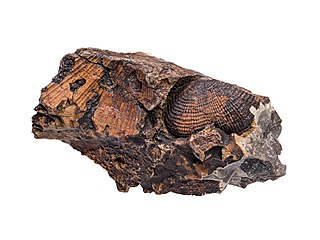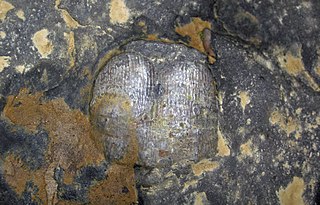
The Fort Union Formation is a geologic unit containing sandstones, shales, and coal beds in Wyoming, Montana, and parts of adjacent states. In the Powder River Basin, it contains important economic deposits of coal, uranium, and coalbed methane.

The Allegheny Group, often termed the Allegheny Formation, is a Pennsylvanian-age geological unit in the Appalachian Plateau. It is a major coal-bearing unit in the eastern United States, extending through western and central Pennsylvania, western Maryland and West Virginia, and southeastern Ohio. Fossils of fishes such as Bandringa are known from the Kittaning Formation, which is part of the Allegheny Group.

The Marjum Formation is a Cambrian geological formation that overlies the Wheeler Shale in the House Range, Utah. It is named after its type locality, Marjum Pass, and was defined in 1908. The formation is known for its occasional preservation of soft-bodied tissue, and is slightly younger than the Burgess Shale, falling in the Ptychagnostus praecurrens trilobite zone.

Paleontology in Oklahoma refers to paleontological research occurring within or conducted by people from the U.S. state of Oklahoma. Oklahoma has a rich fossil record spanning all three eras of the Phanerozoic Eon. Oklahoma is the best source of Pennsylvanian fossils in the United States due to having an exceptionally complete geologic record of the epoch. From the Cambrian to the Devonian, all of Oklahoma was covered by a sea that would come to be home to creatures like brachiopods, bryozoans, graptolites and trilobites. During the Carboniferous, an expanse of coastal deltaic swamps formed in areas of the state where early tetrapods would leave behind footprints that would later fossilize. The sea withdrew altogether during the Permian period. Oklahoma was home a variety of insects as well as early amphibians and reptiles. Oklahoma stayed dry for most of the Mesozoic. During the Late Triassic, carnivorous dinosaurs left behind footprints that would later fossilize. During the Cretaceous, however, the state was mostly covered by the Western Interior Seaway, which was home to huge ammonites and other marine invertebrates. During the Cenozoic, Oklahoma became home to creatures like bison, camels, creodonts, and horses. During the Ice Age, the state was home to mammoths and mastodons. Local Native Americans are known to have used fossils for medicinal purposes. The Jurassic dinosaur Saurophaganax maximus is the Oklahoma state fossil.

Archipolypoda is an extinct group of millipedes known from fossils in Europe and North America and containing the earliest known land animals. The Archipolypoda was erected by Scudder (1882) but redefined in 2005 with the description of several new species from Scotland. Distinguishing characteristics include relatively large eyes with densely packed ocelli, and modified leg pairs on the 8th body ring. Some species had prominent spines while others had a flattened appearance.
The Sharps Formation is a geologic formation in South Dakota. It preserves fossils dating back to the Paleogene.
Schizophoria is an extinct genus of brachiopod belonging to the superfamily Enteletoidea. Specimens have been found in Devonian through Permian beds in North America, Australia, central and southeast Asia, and eastern Europe.

Marginifera is an extinct genus of brachiopod belonging to the order Productida. Specimens have been found in Carboniferous to Triassic beds in Asia, Europe, Madagascar, and North America.
Pugnoides is an extinct genus of brachiopod belonging to the order Rhynchonellida and family Petasmariidae. Specimens have been found in Devonian to Permian beds in North America, Asia, Europe, western Australia, New Zealand,and New Zealand. The genus was particularly widespread in the Visean.

Productidae is an extinct family of brachiopods which lived from the Upper Devonian to Upper Permian periods in marine environments. It is the most diversified family in the suborder Productidina, with some 100 genera.

Echinoconchidae is an extinct family of brachiopods which lived from the Lower Carboniferous to Upper Permian periods in marine habitats. Currently, four subfamilies are assigned to it, though the evolutionary relationships between them and the family Productidae have been heavily debated for the better part of the 20th Century.

Echinoconchinae is an extinct subfamily of brachiopods which lived during the Carboniferous and Permian periods in marine habitats. The family had a cosmopolitan distribution.

Echinoconchus is an extinct genus of brachiopods which lived during the Lower Carboniferous period. The genus was abundant and had a cosmopolitan distribution.
Echinaria is an extinct genus of brachiopods which lived during the Upper Carboniferous and Lower Permian periods. Its fossils have been found in Eurasia, North America and northern South America.
Juresaniinae is an extinct subfamily of brachiopods which lived during the Carboniferous and Permian periods in marine habitats.
Pustulinae is an extinct subfamily of medium to large-sized brachiopods which lived during the Early Carboniferous period in marine habitats. It is named after the type genus Pustula.

Antiquatonia is an extinct genus of brachiopod belonging to the order Productida and family Productidae. Specimens have been found in Carboniferous beds across many continents, suggesting the genus had a cosmopolitan distribution. Species level taxonomy of Antiquatonia is in need of revision.
Pustula is an extinct genus of brachiopods which lived during the Carboniferous period. It is the type genus of the subfamily Pustulinae. Its fossils have been found in Eurasia, North America and northern Africa.
Pulchratia is an extinct genus of brachiopods which lived in marine habitats during the Upper Carboniferous period. Its fossils have been found in North America.








